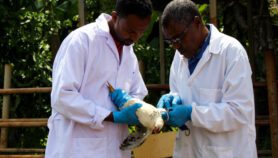By: Eduardo Viotti
Send to a friend
The details you provide on this page will not be used to send unsolicited email, and will not be sold to a 3rd party. See privacy policy.
We need to move beyond using spending on research and development (R&D) as an indicator of innovation to a systems perspective, writes Eduardo Viotti.
How can we best assess a country’s development in science, technology and innovation (STI)? Many would say we can do this simply by measuring the deployment of R&D resources — but this does not give us the full picture.
It is certainly true that R&D spending is one key indicator of the health of a country’s STI development. But it is also true that such R&D indicators measure only a small part of a more complex process.
This focus on R&D spending stems partly from its long history as an indicator; statistics are available dating back several decades in many countries. But it is also the case that most scientists and policymakers still believe innovations and technological developments are an almost natural by-product of R&D efforts.
From this perspective, innovation is seen as the final stage of a linear process that begins with basic research and is followed by applied research and experimental development. If this were the case, indicators, as well as STI policy more generally, should essentially focus on R&D.
In reality, however, many advances in scientific knowledge that come from R&D have no significant impact on technological development. Conversely, while many innovations or technologies depend on advances in basic and applied research, some do not.
Technology first, knowledge later
Steam engines, for instance, were developed, optimised and widely used before the establishment of thermodynamics — the field of scientific knowledge that explains how they work. Containers, an innovation responsible for a genuine revolution in transportation, required no new scientific knowledge, or even any meaningful applied research.
Indeed the development of several new scientific fields has itself been a consequence of technological advances. So the linear model is an oversimplification of reality.
Furthermore, the use, absorption, diffusion and improvement of innovations or technologies that are not new do not follow the linear model. When R&D plays a role in those processes, ‘development’ seems to be much more important than ‘research’.
For example, the linear model is not useful for understanding Japanese and Korean technological development associated with their late industrialisation or catch-up processes.
Letting the linear model and its emphasis on R&D guide our understanding and actions often leads to policies that emphasise the advance of pure science, academic excellence and rigour — at the expense of relevance.
This encourages the alignment of domestic research agendas with those of developed economies, hindering the pursuit of STI policies and programmes that address local needs or which have any chance of generating results that can be profitably used by local entrepreneurs.
The linear model also usually gives only a minor role to the most important users of technologies and creators of innovations: business enterprises and public service providers.
The innovation systems approach
One way of dealing with the complexity and non-linearity of the innovation process is the national innovation systems (NIS) approach, as endorsed, for example, by the Organisation for Economic Cooperation and Development (OECD).
This systemic approach does not assume a preconceived and unidirectional determination of the relations between basic research, applied research, development and innovation. Instead, it looks at the institutions, agents and relationships whose interaction fosters or hinders the production, diffusion and use of innovations. And enterprises — the true agents of innovation — play a central role.
Several indicators associated with the NIS approach come from innovation surveys of companies. These include the number and proportion of innovative firms; expenditure on activities related to innovation (R&D, training, design, equipment and others); sources of information relevant to innovation; technological collaboration; and obstacles to innovation.
Innovation surveys are nowadays regularly collected in most developed economies, and increasingly in developing countries, including Argentina, Brazil, Chile, Colombia, India, Malaysia, Mexico, South Africa, Thailand and Uruguay.
Surveys of innovation generally take as their main reference the ‘Oslo Manual: guidelines for collecting and interpreting innovation data’. The latest edition of the manual, published by the OECD and Eurostat in 2005, includes a section on carrying out innovation surveys in developing economies. It stresses the importance of surveying non-innovative firms as well as innovative companies, as surveys in developed economies are almost exclusively concerned with the latter.
It also recommends paying special attention to the capabilities of companies to absorb, adapt and possibly generate innovations. Emphasis on the measurement of indicators related to a company’s human resources and their use of information and communication technologies are potential ways of assessing those capabilities.
Relevance to developing economies
The call for the collection and use of innovation indicators is not a proposal to replace or disregard R&D indicators. These remain important, but they are insufficient to gauge the health of a country’s STI processes for development.
Innovation indicators are even more important for developing economies because STI processes in these countries are still in their infancy, so virtually none of the innovations or technologies they employ can be traced back to domestic R&D.
And while R&D indicators in developing countries usually rely on relatively good estimates of the R&D activities of universities and research institutions, they can also make use of poor or rough estimates of business R&D.
We are now seeing innovation surveys in several developing economies —such as Brazil and Colombia — being used for collecting their first reliable estimates of business R&D activities. Hopefully the collection of innovation surveys and their use for analysis and policymaking will spread across the developing world.
Eduardo Viotti is an associate researcher at the Center for Sustainable Development at the University of Brasilia and advisor on science and technology policy to the Brazilian Senate.
Download the Oslo Manual edition in English, Russian, Spanish, French or Portuguese ![]() [745kB].
[745kB].













